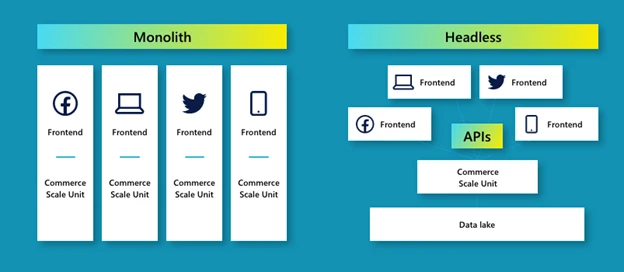
Dynamics 365 powers social shopping needs with headless commerce
Over the last 15 years, social media has grown rapidly, both in reach and in impact on our daily lives. Facebook reached one billion users worldwide in 2012, only eight years after launch, and has approximately 2.89 billion active users today. Instagram boasts nearly 140 million active users, while 100 million people enjoy TikTok.1 Beyond their reach, users spend an exorbitant amount of time on social media, with 62 percent of users spending an hour or more on social media a day and 30 percent spending more than two hours.2
Whether engaging with influencers on live-streaming video platforms or viewing short-form videos on Tiktok, social media has revolutionized the way we connect with each other. They have also changed how we discover and engage with brands, unlocking new opportunities for businesses to engage with customers. And with the emergence of social commerce, they’re opening a new channel through which customers can buy products from retailers.
While the concept of linking to a product page within a social media post has been status quo for some time, consumers prefer a seamless experience that won’t disrupt their consumption. Enter social commerce, which can be thought of as the extension of the shopping experience to the realm of social media. With social commerce, users can see an item on a social media platform and purchase it without leaving the channel.
According to Statista, the value of social commerce sales worldwide in 2021 was an estimated $732 billion and is projected to grow to $2.9 trillion by 2026.3 The continued growth of social media and the coming rise of social commerce will allow companies to add new revenue streams by meeting their customers on the platforms they prefer. The opportunity is not, however, without challenges and brand leaders need to understand how the right technology solutions can help them on their social commerce journey.
Engagement through social media
Given the vast audiences that social media can reach, it makes sense that businesses first gravitated to social media primarily as a means of building awareness for their brand. Today, more and more brands are moving beyond awareness by embracing shoppable Facebook pages and Instagram posts, and the reason is clear: in 2021, 63 percent of social media users reported that posts by a brand or company were very/somewhat influential in their purchasing decisions, according to Sprout Social.4
In addition to making purchases through social media platforms, the forms of media that brands are using to engage consumers are expanding, as well. For example, live-streaming, which draws audiences by combining live entertainment with the ability to purchase directly in a platform, has taken off in China. Given the direct-to-consumer benefits, live-streaming will likely be a hit in other markets soon.
These trends point clearly to the need for brands to be able to offer content across multiple social media platforms and multiple media types to keep up with their customer’s buying preferences. The challenge for many organizations will be overcoming the constraints of their legacy commerce solutions to capitalize on this evolution.
Headless commerce
As omnichannel retail took flight around 2010, retailers came to realize that the first-generation e-commerce platforms were not agile enough to keep pace with the evolution of shoppers’ needs. Whether in-store or online, today’s shoppers want consistent messaging, seamless and sensory experiences across devices, and personalized customer service. Plus, they want unprecedented levels of convenience—all points we’ve discussed in previous blog posts.
Now, with the rise of social commerce, retailers face an increased proliferation of customer touchpoints, such as offering the ability to purchase a product via an influencer’s TikTok video, through a shoppable post on Instagram, or in the virtual world presented in AR/VR. Each of these touchpoints can be thought of as a different “front-end” experience that “back-end” systems, such as content management systems (CMS) and traditional enterprise resource planning (ERP) systems, must serve and connect to enable social commerce.
Delivering social commerce to multiple front-ends in this manner is challenging for organizations that are unable to leverage a single CMS or are still utilizing monolithic, content-led commerce architectures. Headless commerce solves these challenges by disconnecting the front-end experiences from the back-end systems that enable them. In this way, headless solutions give retailers the ability to provide features like platform-specific content and layout management, personalization, content testing, and analytics. Social commerce enables an organization to deploy content on multiple social media platforms (front-end) while still utilizing the same back-end systems to complete transactions. Not only does this simplify management by bringing all commerce-related activities into a single solution, but it also gives retailers the agility necessary to compete in a future of social commerce.

What’s next?
New social channels and customer touchpoints will continue to evolve and develop, and brands need new digital commerce approaches—such as headless commerce—to provide the agility required to adapt to a fast-moving marketplace.
Microsoft Dynamics 365 Commerce is a modern, intelligent, and modular solution that can help organizations consistently deliver great customer experiences on any social channel or front-end application. This is because Dynamics 365 Commerce can utilize both headless and other modern commerce architectures to seamlessly connect enterprise systems, such as payment processing, content management, and omnichannel inventory. By connecting and unifying every facet of the customer journey, businesses are well-positioned to embrace social commerce experiences across established and emerging channels, giving them the ability to meet their customers where they are and purchase there too.
To see how Dynamics 365 Commerce can help your brand succeed in social commerce and beyond, we invite you to get started with Dynamics 365 Commerce free trial today.
Sources:
1- Statista, 2021. Most popular social networks worldwide as of October 2021.
3- Statista, 2021. Social Commerce.
4- Sprout Social, 2021. The state of social media investment: Five key takeaways for European businesses.



